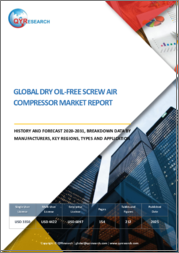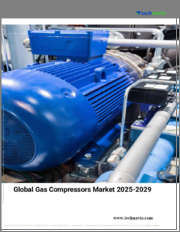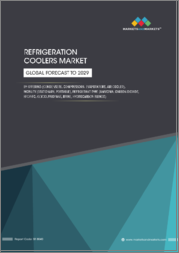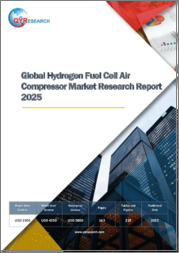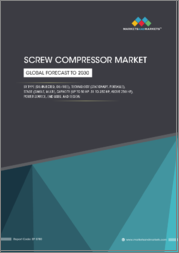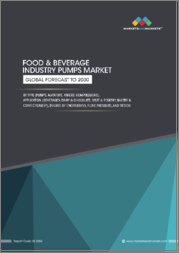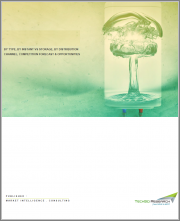
|
시장보고서
상품코드
1348755
자동차용 AC 컴프레서 시장 - 세계 산업 규모, 점유율, 동향, 기회, 예측(2018-2028년)Automotive AC Compressor Market - Global Industry Size, Share, Trends, Opportunity, and Forecast, 2018-2028 Segmented By Vehicle Type, By Drive Type, By Sales Channel, By Design Type, By Region |
||||||
세계 자동차용 AC 컴프레서 시장은 전 세계 승용차 및 상용차 수요 증가로 인해 매년 큰 폭으로 성장하고 있으며, 시장 성장세가 지속될 것으로 예상됩니다.
시장의 성장은 소비자 행동의 변화, 편안하고 고급스러운 차량에 대한 세계인의 선호도 증가, 차량 도입 증가 등 여러 가지 요인에 의해 이루어집니다.
AC 컴프레서에는 가변 용량, 고정 용량, 전기 컴프레서 등 다양한 기술이 있습니다. 가변 용량 컴프레서는 에너지 효율과 성능 향상으로 인해 인기를 끌고 있습니다. 자동차용 AC 컴프레서 시장은 에너지 효율 개선, 배기가스 배출량 감소, 전반적인 성능 향상을 위한 기술 발전을 목격하고 있습니다. 또한, 환경 규제를 준수하기 위해 환경 친화적인 냉매의 개발에도 많은 관심이 집중되고 있습니다. 충전소 및 지원 시스템을 포함한 전기 이동성 인프라의 개발은 자동차용 AC 컴프레서 시장에 직접적인 영향을 미치고 있습니다.
시장 개요
세계 자동차용 AC 컴프레서 시장 촉진요인
자동차용 AC 컴프레서 산업의 성장은 자동차 생산과 관련이 있습니다. 전 세계 자동차 생산량이 증가함에 따라(특히 신흥국에서) AC 컴프레서에 대한 수요도 증가하고 있습니다. 신흥국에서는 자동차 보유량이 증가함에 따라 AC 컴프레서에 대한 수요가 증가하고 있습니다. 소비자들은 자동차의 편안함과 고급스러움을 중요하게 여기고 있습니다. 쾌적한 운전 경험을 위해서는 공조 장비, 특히 효율적인 AC 컴프레서가 중요하다고 여겨지고 있습니다. 쾌적하고 통제된 차량 내 환경에 대한 소비자의 기대치가 높아지면서 AC 컴프레서의 첨단 기술에 대한 수요를 촉진하고 있습니다. 한편, 온실가스 배출량 감소와 연비 향상을 목표로 하는 환경법은 자동차용 AC 컴프레서 사업에 큰 영향을 미치고 있습니다. 각 제조사들은 전력 소비를 줄이고 오염물질 배출을 줄이는 에너지 효율이 높은 컴프레서 생산에 주력하고 있습니다. 법규에 대응하기 위해 가변용량 컴프레서, 전동식 컴프레서 사용, 친환경 냉매 사용 등이 이루어지고 있습니다.
세계 자동차용 AC 컴프레서 시장 동향
자동차용 AC 컴프레서 시장은 끊임없이 기술적으로 진화하고 있으며, AC 컴프레서 제조업체는 제품의 효율성, 신뢰성 및 성능을 향상시키기 위해 연구개발에 투자하고 있습니다. 컴프레서 설계, 재료 및 제어 시스템의 혁신이 그 예입니다. 공조 시스템에 스마트 및 커넥티드 기능을 통합하는 것이 일반화되고 있으며, 모바일 애플리케이션을 통해 원격 제어 및 제어가 가능해졌습니다.
세계 자동차용 AC 컴프레서 시장의 과제
자동차 산업은 매우 주기적이며 경기 변동에 영향을 받기 쉽습니다. 경기 침체, 소비자 구매력 변화, 지정학적 불확실성 등의 요인으로 인해 자동차 시장 수요는 크게 변동될 수 있습니다. 이러한 변동은 자동차용 AC 컴프레서 수요에 직접적인 영향을 미쳐 시장 변동과 예측 및 생산 계획의 어려움으로 이어집니다.
세계 자동차용 AC 컴프레서 시장은 경쟁이 치열하며, 여러 기존 업체와 신규 진입업체가 시장 점유율을 놓고 경쟁하고 있습니다. 경쟁사들은 혁신적이고 비용 효율적인 컴프레서 솔루션을 도입하기 위해 연구개발에 투자하고 있습니다. 이러한 치열한 경쟁은 시장 진입 기업들에게 제품 차별화, 수익성 유지, 시장 지위 유지라는 과제를 안겨주고 있습니다. 마찬가지로 자동차 제조업체는 생산 공정을 최적화하고 전체 차량 비용을 절감해야 하는 비용 압박에 직면해 있으며, AC 컴프레서는 자동차 공조 시스템의 구성요소이기 때문에 비용 최적화가 매우 중요합니다.
컴프레서 제조업체는 고품질의 효율적인 컴프레서의 필요성과 비용 경쟁력 사이에서 균형을 맞춰야 하는데, 이는 재료, 제조 공정 및 규제 요건을 충족하는 데 어려움이 있을 수 있습니다. 냉매 및 배출 기준 제한과 같은 환경 규제는 자동차용 AC 컴프레서 시장에 도전이 되고 있습니다. 변화하는 규제에 대응하고 환경적으로 지속가능한 관행에 투자하는 것은 어려운 일이며 많은 투자가 필요합니다.
자동차용 AC 컴프레서 시장은 기술 발전과 고객 기대치의 진화로 인해 복잡성이 증가하고 있습니다. 컴프레서는 환경 규제를 준수하고, 에너지 효율을 제공해야 하며, 첨단 차량 제어 시스템과 통합되어야 합니다. 이러한 복잡성으로 인해 제조업체는 진화하는 기술에 대응하고 변화하는 고객 요구 사항을 충족하기 위해 연구 개발에 투자해야 합니다.
AC 컴프레서 시장을 포함한 세계 자동차 산업은 COVID-19의 대유행으로 인해 큰 영향을 받았습니다. 제조 시설의 일시적인 가동 중단으로 인해 공급망이 혼란에 빠졌고, 자동차 판매 감소는 시장에 부정적인 영향을 미쳤습니다. 그러나 자동차 산업이 점차 회복되고 시장은 다시 활기를 되찾고 있습니다.
세계 자동차용 AC 컴프레서 시장 기회
자동차용 AC 컴프레서 시장은 신흥 경제 국가를 중심으로 지속적으로 성장하고 있습니다. 더 많은 사람들이 자동차를 구매할 수 있게 됨에 따라 자동차용 AC 컴프레서의 수요는 향후 몇 년 동안 증가할 것으로 예상됩니다. 마찬가지로 고객은 자동차에서 더 편안하고 고급스러운 기능을 원합니다. 최근 자동차에는 에어컨 시스템이 장착되어 자동차용 AC 컴프레서에 대한 수요가 증가하고 있습니다. 자동차용 AC 컴프레서 제조업체에게 전기자동차의 등장은 향후 몇 년 동안 새로운 기회를 가져다 줄 것입니다. 전기자동차의 보급과 함께 전기 AC 컴프레서에 대한 수요가 증가할 것으로 예상됩니다. 인도, 중국 및 기타 아시아 국가와 같은 신흥 시장에서는 자동차 부문이 크게 성장할 것으로 예상됩니다. 이는 전 세계 AC 컴프레서 제조업체들이 이 지역에서 시장 입지와 영향력을 확대할 수 있는 좋은 기회가 될 것입니다.
사용 가능한 커스터마이징
TechSci Research는 주어진 시장 데이터를 바탕으로 기업 고유의 요구에 따라 맞춤화할 수 있습니다. 보고서에서 다음과 같은 커스터마이징이 가능합니다.
회사 소개
- 추가 시장 진입 기업(최대 5개사)에 대한 심층 분석 및 프로파일링
목차
제1장 서론
제2장 조사 방법
제3장 주요 요약
제4장 세계의 자동차용 AC 컴프레서 시장에 대한 COVID-19의 영향
- 영향을 받는 주요 부문
- 영향을 받는 주요 지역
- 영향을 받는 주요 국가
제5장 VOC(고객의 소리)
제6장 세계의 자동차용 AC 컴프레서 시장 전망
- 시장 규모와 예측
- 금액·수량별
- 시장 점유율과 예측
- 차종 유형별(승용차, 소형 상용차(LCV), 중·대형 상용차(M&HCV))
- 구동 유형별(전동, 기존)
- 판매 채널별(OEM, 교체)
- 설계 유형별(왕복 유형, 로터리 유형)
- 지역별
- 기업별(상위 5개사, 기타 - 금액 기준, 2022년)
- 세계의 자동차용 AC 컴프레서 시장 매핑과 기회 평가
- 차종 유형별
- 구동 유형별
- 판매 채널별
- 설계 유형별
- 지역별
제7장 북미의 자동차용 AC 컴프레서 시장 전망
- 시장 규모와 예측
- 금액·수량별
- 시장 점유율과 예측
- 차종별
- 구동 유형별
- 판매 채널별
- 디자인 유형별
- 국가별
- 북미 : 국가별 분석
- 미국
- 캐나다
- 멕시코
제8장 아시아태평양의 자동차용 AC 컴프레서 시장 전망
- 시장 규모와 예측
- 금액·수량별
- 시장 점유율과 예측
- 차종별
- 구동 유형별
- 판매 채널별
- 디자인 유형별
- 국가별
- 아시아태평양 : 국가별 분석
- 중국
- 인도
- 일본
- 말레이시아
- 태국
- 인도네시아
- 베트남
- 한국
제9장 유럽 및 CIS의 자동차용 AC 컴프레서 시장 전망
- 시장 규모와 예측
- 금액·수량별
- 시장 점유율과 예측
- 차종별
- 구동 유형별
- 판매 채널별
- 디자인 유형별
- 국가별
- 유럽·CIS : 국가별 분석
- 독일
- 프랑스
- 영국
- 스페인
- 이탈리아
- 벨기에
- 러시아
제10장 남미의 자동차용 AC 컴프레서 시장 전망
- 시장 규모와 예측
- 금액·수량별
- 시장 점유율과 예측
- 차종별
- 구동 유형별
- 판매 채널별
- 디자인 유형별
- 국가별
- 남미 : 국가별 분석
- 브라질
- 아르헨티나
- 콜롬비아
제11장 중동 및 아프리카의 자동차용 AC 컴프레서 시장 전망
- 시장 규모와 예측
- 금액·수량 기준
- 시장 점유율과 예측
- 차종별
- 구동 유형별
- 판매 채널별
- 디자인 유형별
- 국가별
- 중동 및 아프리카 : 국가별 분석
- 남아프리카공화국
- 아랍에미리트
- 사우디아라비아
- 이집트
제12장 시장 역학
- 시장 성장 촉진요인
- 시장 과제
제13장 시장 동향과 발전
제14장 Porter's Five Forces 분석
- 경쟁 기업 간의 경쟁 관계
- 공급 기업의 교섭력
- 구매자의 교섭력
- 신규 참여업체의 위협
- 대체품의 위협
제15장 경쟁 상황
- 기업 개요(주요 상위 10개사)
- Behr Hella Service GmbH.
- 기업 개요
- 주요 제공 제품
- 최근 발전
- 주요 관리 인재
- Calsonic Kansei Corporation
- 기업 개요
- 주요 제공 제품
- 최근 발전
- 주요 관리 인재
- Continental AG
- 기업 개요
- 주요 제공 제품
- 최근 발전
- 주요 관리 인재
- Delphi Technologies
- 기업 개요
- 주요 제공 제품
- 최근 발전
- 주요 관리 인재
- Hanon Systems(Dalian) Co., Ltd.
- 기업 개요
- 주요 제공 제품
- 최근 발전
- 주요 관리 인재
- Subros Limited
- 기업 개요
- 주요 제공 제품
- 최근 발전
- 주요 관리 인재
- Robert Bosch Gmbh
- 기업 개요
- 주요 제공 제품
- 최근 발전
- 주요 관리 인재
- Behr Hella Service GmbH.
제16장 전략적 제안
- 중점 분야
- 대상 지역과 국가
- 대상 차종
- 대상 구동 유형
문의 및 면책사항
ksm 23.11.08Global Automotive AC Compressor Market is expected to grow as the market is experiencing significant growth over the years due to the rising demand for passenger and commercial vehicles globally. The market's growth is driven by several factors like changing consumer behavior, the growing preference for comfortable and luxurious vehicles globally and the increase in vehicle adoption.
AC compressors are available in various technologies, such as variable displacement, fixed displacement, and electric compressors. Variable displacement compressors are gaining popularity due to their energy efficiency and improved performance. The Automotive AC Compressor Market is witnessing technological advancements to improve energy efficiency, reduce emissions, and enhance overall performance. Additionally, there is a growing focus on developing eco-friendly refrigerants to comply with environmental regulations. The development of electric mobility infrastructure, including charging stations and support systems, has a direct impact on the Automotive AC Compressor Market.
| Market Overview | |
|---|---|
| Forecast Period | 2024-2028 |
| Market Size 2022 | USD 7.56 Billion |
| Market Size 2028F | USD 12.14 Billion |
| CAGR (2023-2028) | 4.56% |
| Fastest Growing Segment | Conventional |
| Largest Market | Asia-Pacific |
Market Overview
Global Automotive AC Compressor Market Drivers
The growth of the automotive AC compressor industry is related to vehicle production. As worldwide vehicle manufacturing continues to climb, particularly in emerging nations, so does demand for AC compressors. In emerging countries, the increasing automobile ownership is resulting in higher demand for AC compressors. Consumers are emphasizing comfort and luxury aspects in automobiles. For a comfortable driving experience, air conditioning equipment, especially efficient AC compressors, are deemed important. Consumer expectations for a pleasant and controlled cabin climate are increasing, which adds to the demand for sophisticated AC compressor technologies. Environmental laws aiming at decreasing greenhouse gas emissions and boosting fuel efficiency, on the other hand, have a substantial impact on the automotive AC compressor business. Manufacturers are concentrating on building energy-efficient compressors that use less electricity and emit less pollution. To meet with laws, it involves the use of variable displacement and electric compressors, as well as the use of eco-friendly refrigerants.
Global Automotive AC Compressor Market Trends
The automobile AC compressor market is constantly evolving technologically. AC compressor manufacturers are investing in R&D to increase the efficiency, dependability, and performance of their products. Innovations in compressor design, materials, and control systems are examples of it. Integration of smart and connected features in air conditioning systems is becoming popular, allowing for remote operation and control via mobile applications.
The increasing popularity of electric and hybrid vehicles has an impact on the automotive air conditioning compressor market. These cars necessitate electric compressors rather than traditional belt-driven compressors, opening new markets for the producers. Electric compressors that are lightweight and compact, as well as developments in thermal management systems for electric vehicles, are major trends in this market. The aftermarket segment is important in the vehicle AC compressor industry. As vehicles age and their original air conditioning compressors fail, the demand for aftermarket compressors rises. Aftermarket demand for AC compressors is influenced by factors such as vehicle maintenance, repairs, and the requirement for upgrades.
The expanding global vehicle fleet, coupled with rapid urbanization, drives the demand for automotive AC compressors. As more people migrate to urban areas, the demand for vehicles equipped with air conditioning systems rises. Additionally, extreme climate conditions in certain regions increase the need for efficient AC systems, further boosting the demand for compressors.
Global Automotive AC Compressor Market Challenges
The automotive industry is highly cyclical and sensitive to economic fluctuations. Market demand for vehicles can vary significantly due to factors such as economic downturns, changes in consumer purchasing power, and geopolitical uncertainties. These fluctuations directly impact the demand for automotive AC compressors, leading to market volatility and challenges in forecasting and production planning.
The global automotive AC compressor market is highly competitive, with several established players and new entrants vying for market share. Competing companies invest in research and development to introduce innovative and cost-effective compressor solutions. This intense competition poses challenges for market players to differentiate their products, maintain profitability, and sustain market position. Similarly, Automotive manufacturers face cost pressures to optimize their production processes and reduce overall vehicle costs. As AC compressors are a component of a vehicle's air conditioning system, cost optimization becomes crucial.
Compressor manufacturers must balance the need for high-quality and efficient compressors with cost competitiveness, which can be challenging in terms of materials, manufacturing processes, and meeting regulatory requirements. Environmental regulations, such as restrictions on refrigerants and emission standards, pose challenges for the automotive AC compressor market. Adapting to changing regulations and investing in environmentally sustainable practices can be challenging and require substantial investments.
The automotive AC compressor market is subject to increasing complexity due to advancements in technology and evolving customer expectations. Compressors need to comply with environmental regulations, offer energy efficiency, and integrate with advanced vehicle control systems. This complexity requires manufacturers to invest in research and development to keep pace with evolving technologies and meet changing customer demands.
The global automotive industry, including the AC compressor market, faced a significant impact due to the COVID-19 pandemic. The temporary shutdown of manufacturing facilities disrupted supply chains, and reduced vehicle sales negatively affected the market. However, with the gradual recovery of the automotive industry, the market is regained momentum.
Global Automotive AC Compressor Market Opportunity
The market for automotive AC compressors has been expanding consistently, especially in developing economies. The need for automotive AC compressors is anticipated to increase in the forecast years as more people can buy vehicles. Similarly, Customers are looking for more comfort and luxury features in their cars. Modern cars are equipped with air conditioning systems, which raises the demand for automotive AC compressors. For manufacturers of automotive AC compressors, the rise of electric vehicles presents new opportunities in the coming years. Demand for electric AC compressors is expected to increase as EV adoption grows. In rising markets such as India, China, and other Asian countries, the automotive sector is predicted to grow dramatically. This creates a significant opportunity for global AC compressor manufacturers to increase their market presence and reach in these regions.
Market Segmentation
The Global Automotive AC Compressor Market is segmented By Vehicle Type, By Drive Type, By Sales Channel, By Design Type and By Region. Based on Vehicle Type, the market is segmented into Passenger Cars, Light Commercial Vehicle (LCV), Medium and Heavy Commercial Vehicles (M&HCV). Based on Drive Type, the market is segmented by electric and conventional. Similarly, based on sales channel the market is segmented into OEM and Replacement. Based on design type the market is segmented into Reciprocating Type and Rotary Type. The market analysis also studies the region wise segmentation to devise market.
Company Profiles
Behr Hella Service GmbH, Calsonic Kansei Corporation, Continental AG, Delphi Technologies, Denso Corporation, Hanon Systems (Dalian) Co., Ltd, Subros Limited, Robert Bosch Gmbh etc. are the leading companies operating globally in the market.
Report Scope:
In this report, Global Automotive AC Compressor Market has been segmented into following categories, in addition to the industry trends which have also been detailed below:
Automotive AC Compressor Market, By Vehicle Type:
- Passenger Cars
- Light Commercial Vehicles (LCV)
- Medium and Heavy Commercial Vehicles (M&HCV)
Automotive AC Compressor Market, By Drive Type:
- Electric
- Conventional
Automotive AC Compressor Market, By Sales Channel:
- OEM
- Replacement
Automotive AC Compressor Market, By Design Type:
- Reciprocating
- Rotary Type
Automotive AC Compressor Market, By Region:
- Asia-Pacific
- China
- India
- Japan
- Malaysia
- Thailand
- Indonesia
- Vietnam
- South Korea
- North America
- United States
- Canada
- Mexico
- Europe & CIS
- Germany
- France
- United Kingdom
- Spain
- Italy
- Belgium
- Russia
- South America
- Brazil
- Argentina
- Colombia
Competitive Landscape
Company Profiles: Detailed analysis of the major companies present in Global Automotive AC Compressor Market.
Available Customizations:
With the given market data, TechSci Research offers customizations according to a company's specific needs. The following customization options are available for the report:
Company Information
- Detailed analysis and profiling of additional market players (up to five).
Table of Contents
1. Introduction
- 1.1. Product Overview
- 1.2. Key Highlights of the Report
- 1.3. Market Coverage
- 1.4. Market Segments Covered
- 1.5. Research Tenure Considered
2. Research Methodology
- 2.1. Objective of the Study
- 2.2. Baseline Methodology
- 2.3. Key Industry Partners
- 2.4. Major Association and Secondary Sources
- 2.5. Forecasting Methodology
- 2.6. Data Triangulation & Validation
- 2.7. Assumptions and Limitations
3. Executive Summary
- 3.1. Market Overview
- 3.2. Market Forecast
- 3.3. Key Regions
- 3.4. Key Segments
4. Impact of COVID-19 on Global Automotive AC Compressor Market
- 4.1. Key Segments Impacted
- 4.2. Key Regions Impacted
- 4.3. Key Countries Impacted
5. Voice of Customer
- 5.1. Factors Influencing Purchase Decision
- 5.2. Brand Awareness
6. Global Automotive AC Compressor Market Outlook
- 6.1. Market Size & Forecast
- 6.1.1. By Value and Volume
- 6.2. Market Share & Forecast
- 6.2.1. By Vehicle Type Market Share Analysis (Passenger Cars, Light Commercial Vehicles (LCV), Medium and Heavy Commercial Vehicles (M&HCV))
- 6.2.2. By Drive Type Market Share Analysis (Electric and Conventional)
- 6.2.3. By Sales Channel Market Share Analysis (OEM and Replacement)
- 6.2.4. By Design Type Market Share Analysis (Reciprocating Type and Rotary Type)
- 6.2.5. By Regional Market Share Analysis
- 6.2.5.1. North America Market Share Analysis
- 6.2.5.2. Europe Market Share Analysis
- 6.2.5.3. Asia Pacific Market Share Analysis
- 6.2.5.4. South America Market Share Analysis
- 6.2.5.5. Middle East & Africa Market Share Analysis
- 6.2.6. By Company Market Share Analysis (Top 5 Companies, Others - By Value, 2022)
- 6.3. Global Automotive AC Compressor Mapping & Opportunity Assessment
- 6.3.1. By Vehicle Type Market Mapping & Opportunity Assessment
- 6.3.2. By Drive Type Market Mapping & Opportunity Assessment
- 6.3.3. By Sales Channel Market Mapping & Opportunity Assessment
- 6.3.4. By Design Type Market Mapping & Opportunity Assessment
- 6.3.5. By Regional Market Mapping & Opportunity Assessment
7. North America Automotive AC Compressor Market Outlook
- 7.1. Market Size & Forecast
- 7.1.1. By Value and Volume
- 7.2. Market Share & Forecast
- 7.2.1. By Vehicle Type Market Share Analysis
- 7.2.2. By Drive Type Market Share Analysis
- 7.2.3. By Sales Channel Market Share Analysis
- 7.2.4. By Design Type Market Share Analysis
- 7.2.5. By Country Market Share Analysis
- 7.2.5.1. United States Market Share Analysis
- 7.2.5.2. Canada Market Share Analysis
- 7.2.5.3. Mexico Market Share Analysis
- 7.3. North America: Country Analysis
- 7.3.1. United States Automotive AC Compressor Market Outlook
- 7.3.1.1. Market Size & Forecast
- 7.3.1.1.1. By Value and Volume
- 7.3.1.2. Market Share & Forecast
- 7.3.1.2.1. By Vehicle Type Market Share Analysis
- 7.3.1.2.2. By Drive Type Market Share Analysis
- 7.3.1.2.3. By Sales Channel Market Share Analysis
- 7.3.1.2.4. By Design Type Market Share Analysis
- 7.3.1.1. Market Size & Forecast
- 7.3.2. Canada Automotive AC Compressor Market Outlook
- 7.3.2.1. Market Size & Forecast
- 7.3.2.1.1. By Value and Volume
- 7.3.2.2. Market Share & Forecast
- 7.3.2.2.1. By Vehicle Type Market Share Analysis
- 7.3.2.2.2. By Drive Type Market Share Analysis
- 7.3.2.2.3. By Sales Channel Market Share Analysis
- 7.3.2.2.4. By Design Type Market Share Analysis
- 7.3.2.1. Market Size & Forecast
- 7.3.3. Mexico Automotive AC Compressor Market Outlook
- 7.3.3.1. Market Size & Forecast
- 7.3.3.1.1. By Value and Volume
- 7.3.3.2. Market Share & Forecast
- 7.3.3.2.1. By Vehicle Type Market Share Analysis
- 7.3.3.2.2. By Drive Type Market Share Analysis
- 7.3.3.2.3. By Sales Channel Market Share Analysis
- 7.3.3.2.4. By Design Type Market Share Analysis
- 7.3.3.1. Market Size & Forecast
- 7.3.1. United States Automotive AC Compressor Market Outlook
8. Asia Pacific Automotive AC Compressor Market Outlook
- 8.1. Market Size & Forecast
- 8.1.1. By Value and Volume
- 8.2. Market Share & Forecast
- 8.2.1. By Vehicle Type Market Share Analysis
- 8.2.2. By Drive Type Market Share Analysis
- 8.2.3. By Sales Channel Market Share Analysis
- 8.2.4. By Design Type Market Share Analysis
- 8.2.5. By Country Market Share Analysis
- 8.2.5.1. China Market Share Analysis
- 8.2.5.2. India Market Share Analysis
- 8.2.5.3. Japan Market Share Analysis
- 8.2.5.4. Malaysia Market Share Analysis
- 8.2.5.5. Thailand Market Share Analysis
- 8.2.5.6. Indonesia Market Share Analysis
- 8.2.5.7. Vietnam Market Share Analysis
- 8.2.5.8. South Korea Market Share Analysis
- 8.2.5.9. Rest of Asia Pacific Market Share Analysis
- 8.3. Asia Pacific: Country Analysis
- 8.3.1. China Automotive AC Compressor Market Outlook
- 8.3.1.1. Market Size & Forecast
- 8.3.1.1.1. By Value and Volume
- 8.3.1.2. Market Share & Forecast
- 8.3.1.2.1. By Vehicle Type Market Share Analysis
- 8.3.1.2.2. By Drive Type Market Share Analysis
- 8.3.1.2.3. By Sales Channel Market Share Analysis
- 8.3.1.2.4. By Design Type Market Share Analysis
- 8.3.1.1. Market Size & Forecast
- 8.3.2. India Automotive AC Compressor Market Outlook
- 8.3.2.1. Market Size & Forecast
- 8.3.2.1.1. By Value and Volume
- 8.3.2.2. Market Share & Forecast
- 8.3.2.2.1. By Vehicle Type Market Share Analysis
- 8.3.2.2.2. By Drive Type Market Share Analysis
- 8.3.2.2.3. By Sales Channel Market Share Analysis
- 8.3.2.2.4. By Design Type Market Share Analysis
- 8.3.2.1. Market Size & Forecast
- 8.3.3. Japan Automotive AC Compressor Market Outlook
- 8.3.3.1. Market Size & Forecast
- 8.3.3.1.1. By Value and Volume
- 8.3.3.2. Market Share & Forecast
- 8.3.3.2.1. By Vehicle Type Market Share Analysis
- 8.3.3.2.2. By Drive Type Market Share Analysis
- 8.3.3.2.3. By Sales Channel Market Share Analysis
- 8.3.3.2.4. By Design Type Market Share Analysis
- 8.3.3.1. Market Size & Forecast
- 8.3.4. Malaysia Automotive AC Compressor Market Outlook
- 8.3.4.1. Market Size & Forecast
- 8.3.4.1.1. By Value and Volume
- 8.3.4.2. Market Share & Forecast
- 8.3.4.2.1. By Vehicle Type Market Share Analysis
- 8.3.4.2.2. By Drive Type Market Share Analysis
- 8.3.4.2.3. By Sales Channel Market Share Analysis
- 8.3.4.2.4. By Design Type Market Share Analysis
- 8.3.4.1. Market Size & Forecast
- 8.3.5. Thailand Automotive AC Compressor Market Outlook
- 8.3.5.1. Market Size & Forecast
- 8.3.5.1.1. By Value and Volume
- 8.3.5.2. Market Share & Forecast
- 8.3.5.2.1. By Vehicle Type Market Share Analysis
- 8.3.5.2.2. By Drive Type Market Share Analysis
- 8.3.5.2.3. By Sales Channel Market Share Analysis
- 8.3.5.2.4. By Design Type Market Share Analysis
- 8.3.5.1. Market Size & Forecast
- 8.3.6. Indonesia Automotive AC Compressor Market Outlook
- 8.3.6.1. Market Size & Forecast
- 8.3.6.1.1. By Value and Volume
- 8.3.6.2. Market Share & Forecast
- 8.3.6.2.1. By Vehicle Type Market Share Analysis
- 8.3.6.2.2. By Drive Type Market Share Analysis
- 8.3.6.2.3. By Sales Channel Market Share Analysis
- 8.3.6.2.4. By Design Type Market Share Analysis
- 8.3.6.1. Market Size & Forecast
- 8.3.7. Vietnam Automotive AC Compressor Market Outlook
- 8.3.7.1. Market Size & Forecast
- 8.3.7.1.1. By Value and Volume
- 8.3.7.2. Market Share & Forecast
- 8.3.7.2.1. By Vehicle Type Market Share Analysis
- 8.3.7.2.2. By Drive Type Market Share Analysis
- 8.3.7.2.3. By Sales Channel Market Share Analysis
- 8.3.7.2.4. By Design Type Market Share Analysis
- 8.3.7.1. Market Size & Forecast
- 8.3.8. South Korea Automotive AC Compressor Market Outlook
- 8.3.8.1. Market Size & Forecast
- 8.3.8.1.1. By Value and Volume
- 8.3.8.2. Market Share & Forecast
- 8.3.8.2.1. By Vehicle Type Market Share Analysis
- 8.3.8.2.2. By Drive Type Market Share Analysis
- 8.3.8.2.3. By Sales Channel Market Share Analysis
- 8.3.8.2.4. By Design Type Market Share Analysis
- 8.3.8.1. Market Size & Forecast
- 8.3.1. China Automotive AC Compressor Market Outlook
9. Europe & CIS Automotive AC Compressor Market Outlook
- 9.1. Market Size & Forecast
- 9.1.1. By Value and Volume
- 9.2. Market Share & Forecast
- 9.2.1. By Vehicle Type Market Share Analysis
- 9.2.2. By Drive Type Market Share Analysis
- 9.2.3. By Sales Channel Market Share Analysis
- 9.2.4. By Design Type Market Share Analysis
- 9.2.5. By Country Market Share Analysis
- 9.2.5.1. Germany Market Share Analysis
- 9.2.5.2. France Market Share Analysis
- 9.2.5.3. United Kingdom Market Share Analysis
- 9.2.5.4. Spain Market Share Analysis
- 9.2.5.5. Italy Market Share Analysis
- 9.2.5.6. Belgium Market Share Analysis
- 9.2.5.7. Russia Market Share Analysis
- 9.2.5.8. Rest of Europe & CIS Market Share Analysis
- 9.3. Europe & CIS: Country Analysis
- 9.3.1. Germany Automotive AC Compressor Market Outlook
- 9.3.1.1. Market Size & Forecast
- 9.3.1.1.1. By Value and Volume
- 9.3.1.2. Market Share & Forecast
- 9.3.1.2.1. By Vehicle Type Market Share Analysis
- 9.3.1.2.2. By Drive Type Market Share Analysis
- 9.3.1.2.3. By Sales Channel Market Share Analysis
- 9.3.1.2.4. By Design Type Market Share Analysis
- 9.3.1.1. Market Size & Forecast
- 9.3.2. France Automotive AC Compressor Market Outlook
- 9.3.2.1. Market Size & Forecast
- 9.3.2.1.1. By Value and Volume
- 9.3.2.2. Market Share & Forecast
- 9.3.2.2.1. By Vehicle Type Market Share Analysis
- 9.3.2.2.2. By Drive Type Market Share Analysis
- 9.3.2.2.3. By Sales Channel Market Share Analysis
- 9.3.2.2.4. By Design Type Market Share Analysis
- 9.3.2.1. Market Size & Forecast
- 9.3.3. United Kingdom Automotive AC Compressor Market Outlook
- 9.3.3.1. Market Size & Forecast
- 9.3.3.1.1. By Value and Volume
- 9.3.3.2. Market Share & Forecast
- 9.3.3.2.1. By Vehicle Type Market Share Analysis
- 9.3.3.2.2. By Drive Type Market Share Analysis
- 9.3.3.2.3. By Sales Channel Market Share Analysis
- 9.3.3.2.4. By Design Type Market Share Analysis
- 9.3.3.1. Market Size & Forecast
- 9.3.4. Spain Automotive AC Compressor Market Outlook
- 9.3.4.1. Market Size & Forecast
- 9.3.4.1.1. By Value and Volume
- 9.3.4.2. Market Share & Forecast
- 9.3.4.2.1. By Vehicle Type Market Share Analysis
- 9.3.4.2.2. By Drive Type Market Share Analysis
- 9.3.4.2.3. By Sales Channel Market Share Analysis
- 9.3.4.2.4. By Design Type Market Share Analysis
- 9.3.4.1. Market Size & Forecast
- 9.3.5. Italy Automotive AC Compressor Market Outlook
- 9.3.5.1. Market Size & Forecast
- 9.3.5.1.1. By Value and Volume
- 9.3.5.2. Market Share & Forecast
- 9.3.5.2.1. By Vehicle Type Market Share Analysis
- 9.3.5.2.2. By Drive Type Market Share Analysis
- 9.3.5.2.3. By Sales Channel Market Share Analysis
- 9.3.5.2.4. By Design Type Market Share Analysis
- 9.3.5.1. Market Size & Forecast
- 9.3.6. Belgium Automotive AC Compressor Market Outlook
- 9.3.6.1. Market Size & Forecast
- 9.3.6.1.1. By Value and Volume
- 9.3.6.2. Market Share & Forecast
- 9.3.6.2.1. By Vehicle Type Market Share Analysis
- 9.3.6.2.2. By Drive Type Market Share Analysis
- 9.3.6.2.3. By Sales Channel Market Share Analysis
- 9.3.6.2.4. By Design Type Market Share Analysis
- 9.3.6.1. Market Size & Forecast
- 9.3.7. Russia Automotive AC Compressor Market Outlook
- 9.3.7.1. Market Size & Forecast
- 9.3.7.1.1. By Value and Volume
- 9.3.7.2. Market Share & Forecast
- 9.3.7.2.1. By Vehicle Type Market Share Analysis
- 9.3.7.2.2. By Drive Type Market Share Analysis
- 9.3.7.2.3. By Sales Channel Market Share Analysis
- 9.3.7.2.4. By Design Type Market Share Analysis
- 9.3.7.1. Market Size & Forecast
- 9.3.1. Germany Automotive AC Compressor Market Outlook
10. South America Automotive AC Compressor Market Outlook
- 10.1. Market Size & Forecast
- 10.1.1. By Value and Volume
- 10.2. Market Share & Forecast
- 10.2.1. By Vehicle Type Market Share Analysis
- 10.2.2. By Drive Type Market Share Analysis
- 10.2.3. By Sales Channel Market Share Analysis
- 10.2.4. By Design Type Market Share Analysis
- 10.2.5. By Country Market Share Analysis
- 10.2.5.1. Brazil Market Share Analysis
- 10.2.5.2. Argentina Market Share Analysis
- 10.2.5.3. Colombia Market Share Analysis
- 10.2.5.4. Rest of South America Market Share Analysis
- 10.3. South America: Country Analysis
- 10.3.1. Brazil Automotive AC Compressor Market Outlook
- 10.3.1.1. Market Size & Forecast
- 10.3.1.1.1. By Value and Volume
- 10.3.1.2. Market Share & Forecast
- 10.3.1.2.1. By Vehicle Type Market Share Analysis
- 10.3.1.2.2. By Drive Type Market Share Analysis
- 10.3.1.2.3. By Sales Channel Market Share Analysis
- 10.3.1.2.4. By Design Type Market Share Analysis
- 10.3.1.1. Market Size & Forecast
- 10.3.2. Argentina Automotive AC Compressor Market Outlook
- 10.3.2.1. Market Size & Forecast
- 10.3.2.1.1. By Value and Volume
- 10.3.2.2. Market Share & Forecast
- 10.3.2.2.1. By Vehicle Type Market Share Analysis
- 10.3.2.2.2. By Drive Type Market Share Analysis
- 10.3.2.2.3. By Sales Channel Market Share Analysis
- 10.3.2.2.4. By Design Type Market Share Analysis
- 10.3.2.1. Market Size & Forecast
- 10.3.3. Colombia Automotive AC Compressor Market Outlook
- 10.3.3.1. Market Size & Forecast
- 10.3.3.1.1. By Value and Volume
- 10.3.3.2. Market Share & Forecast
- 10.3.3.2.1. By Vehicle Type Market Share Analysis
- 10.3.3.2.2. By Drive Type Market Share Analysis
- 10.3.3.2.3. By Sales Channel Market Share Analysis
- 10.3.3.2.4. By Design Type Market Share Analysis
- 10.3.3.1. Market Size & Forecast
- 10.3.1. Brazil Automotive AC Compressor Market Outlook
11. Middle East and Africa Automotive AC Compressor Market Outlook
- 11.1. Market Size & Forecast
- 11.1.1. By Value and Volume
- 11.2. Market Share & Forecast
- 11.2.1. By Vehicle Type Market Share Analysis
- 11.2.2. By Drive Type Market Share Analysis
- 11.2.3. By Sales Channel Market Share Analysis
- 11.2.4. By Design Type Market Share Analysis
- 11.2.5. By Country Market Share Analysis
- 11.2.5.1. South Africa Market Share Analysis
- 11.2.5.2. UAE Market Share Analysis
- 11.2.5.3. Saudi Arabia Market Share Analysis
- 11.2.5.4. Egypt Market Share Analysis
- 11.2.5.5. Rest of Middle East & Africa Market Share Analysis
- 11.3. Middle East and Africa: Country Analysis
- 11.3.1. South Africa Automotive AC Compressor Market Outlook
- 11.3.1.1. Market Size & Forecast
- 11.3.1.1.1. By Value and Volume
- 11.3.1.2. Market Share & Forecast
- 11.3.1.2.1. By Vehicle Type Market Share Analysis
- 11.3.1.2.2. By Drive Type Market Share Analysis
- 11.3.1.2.3. By Sales Channel Market Share Analysis
- 11.3.1.2.4. By Design Type Market Share Analysis
- 11.3.1.1. Market Size & Forecast
- 11.3.2. UAE Automotive AC Compressor Market Outlook
- 11.3.2.1. Market Size & Forecast
- 11.3.2.1.1. By Value and Volume
- 11.3.2.2. Market Share & Forecast
- 11.3.2.2.1. By Vehicle Type Market Share Analysis
- 11.3.2.2.2. By Drive Type Market Share Analysis
- 11.3.2.2.3. By Sales Channel Market Share Analysis
- 11.3.2.2.4. By Design Type Market Share Analysis
- 11.3.2.1. Market Size & Forecast
- 11.3.3. Saudi Arabia Automotive AC Compressor Market Outlook
- 11.3.3.1. Market Size & Forecast
- 11.3.3.1.1. By Value and Volume
- 11.3.3.2. Market Share & Forecast
- 11.3.3.2.1. By Vehicle Type Market Share Analysis
- 11.3.3.2.2. By Drive Type Market Share Analysis
- 11.3.3.2.3. By Sales Channel Market Share Analysis
- 11.3.3.2.4. By Design Type Market Share Analysis
- 11.3.3.1. Market Size & Forecast
- 11.3.4. Egypt Automotive AC Compressor Market Outlook
- 11.3.4.1. Market Size & Forecast
- 11.3.4.1.1. By Value and Volume
- 11.3.4.2. Market Share & Forecast
- 11.3.4.2.1. By Vehicle Type Market Share Analysis
- 11.3.4.2.2. By Drive Type Market Share Analysis
- 11.3.4.2.3. By Sales Channel Market Share Analysis
- 11.3.4.2.4. By Design Type Market Share Analysis
- 11.3.4.1. Market Size & Forecast
- 11.3.1. South Africa Automotive AC Compressor Market Outlook
12. Market Dynamics
- 12.1. Market Drivers
- 12.2. Market Challenges
13. Market Trends & Developments
14. Porter's Five Forces Model
- 14.1. Competitive Rivalry
- 14.2. Bargaining Power of Suppliers
- 14.3. Bargaining Power of Buyers
- 14.4. Threat of New Entrants
- 14.5. Threat of Substitutes
15. Competitive Landscape
- 15.1. Company Profiles (Up To 10 Major Companies)
- 15.1.1. Behr Hella Service GmbH.
- 15.1.1.1. Company Details
- 15.1.1.2. Key Products Offered
- 15.1.1.3. Recent Development
- 15.1.1.4. Key Management Personnel
- 15.1.2. Calsonic Kansei Corporation
- 15.1.2.1. Company Details
- 15.1.2.2. Key Products Offered
- 15.1.2.3. Recent Development
- 15.1.2.4. Key Management Personnel
- 15.1.3. Continental AG
- 15.1.3.1. Company Details
- 15.1.3.2. Key Products Offered
- 15.1.3.3. Recent Development
- 15.1.3.4. Key Management Personnel
- 15.1.4. Delphi Technologies
- 15.1.4.1. Company Details
- 15.1.4.2. Key Products Offered
- 15.1.4.3. Recent Development
- 15.1.4.4. Key Management Personnel
- 15.1.5. Hanon Systems (Dalian) Co., Ltd.
- 15.1.5.1. Company Details
- 15.1.5.2. Key Products Offered
- 15.1.5.3. Recent Development
- 15.1.5.4. Key Management Personnel
- 15.1.6. Subros Limited
- 15.1.6.1. Company Details
- 15.1.6.2. Key Products Offered
- 15.1.6.3. Recent Development
- 15.1.6.4. Key Management Personnel
- 15.1.7. Robert Bosch Gmbh
- 15.1.7.1. Company Details
- 15.1.7.2. Key Products Offered
- 15.1.7.3. Recent Development
- 15.1.7.4. Key Management Personnel
- 15.1.1. Behr Hella Service GmbH.
16. Strategic Recommendations
- 16.1. Key Focus Areas
- 16.1.1. Target Regions & Countries
- 16.1.2. Target Vehicle Type
- 16.1.3. Target Drive Type
About Us & Disclaimer







